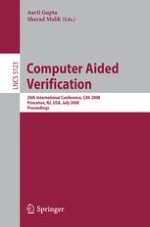This book constitutes the refereed proceedings of the 20th International Conference on Computer Aided Verification, CAV 2008, held in Princeton, NJ, USA, in July 2008. The 33 revised full papers presented together with 14 tool papers and 2 invited papers and 4 invited tutorials were carefully reviewed and selected from 104 regular paper and 27 tool paper submissions. The papers are organized in topical sections on concurrency, memory consistency, abstraction/refinement, hybrid systems, dynamic verification, modeling and specification formalisms, decision procedures, program verification, program and shape analysis, security and program analysis, hardware verification, model checking, space efficient algorithms, and model checking.
